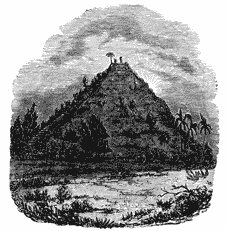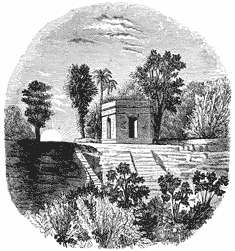One of the World's Leading
Sources of Information On Literature, the Arts, and a Wide Range of
Subjects
Other Ruins in Yucatan
(This is taken from John D. Baldwin's Ancient America, originally published in 1871.)

Izamal, Labna, Zayi, and some of the other ruins are sufficiently important for special notice; but they present every where the same characteristics, differing a little in the style or method of ornamentation. At Labna there is among the ruins an ancient gateway, beautiful in design and construction, a view of which is given in the Frontispiece. The best account of some of the other ruins on this peninsula can be found in the volumes of Mr. Stephens, entitled “Incidents of Travel in Yucatan.” At Zayi there is a singular building, which, as seen at a distance by Mr. Stephens, “had the appearance of a New England factory.” But what seemed to be a “factory” is, in fact, nothing more than a massive wall with oblong openings, which runs along the middle of the roof, and rises thirty feet above it. The building was below this wall, but the front part of it had fallen.
There is a remarkable ruin at Ake, at the south, which deserves mention. Here, on the summit of a great mound, very level, and 225 feet by 50 in extent, stand 36 shafts or columns, in three parallel rows. The columns are about 15 feet high and 4 feet square. The ruins of Ake, which cover a great space, are ruder and more massive than most of the others. The island of Cozumel and the adjacent coast of Yucatan were populous when the Spaniards first went there, but the great towns then inhabited are now in ruins.
Water is scarce on this peninsula, and a sufficient supply is not obtained without considerable difficulty. The ancient inhabitants provided for this lack of water by constructing aguadas or artificial ponds. These, or many of them, doubtless, are as old as the oldest of the ruined cities. Intelligence, much skill in masonry, and much labor were required to construct them. They were paved with several courses of stone laid in cement, and in their bottoms wells or cavities were constructed. More than forty such wells were found in the bottom of one of these aguadas at Galal, which has been repaired and restored to use. In some places long subterranean passages lead down to pools of water, which are used in the dry season.
The wooden lintels, which are common in Yucatan, do not appear in the other ruins, and there is a difference in the style of ornamentation between those at Palenque or Copan, for instance, and those at Uxmal, but every where the architecture is regulated by the same idea, the differences indicating nothing more than different periods and different phases of development in the history of the same people.
Some of the great edifices in these old ruins, such as the “Palace” at Palenque, and the “Casa del Gobernador” at Uxmal, remind us of the “communal buildings” of the Pueblos, and yet there is a wide difference between them. They are not alike either in character or purpose, although such great buildings as the “Palace” may have been designed for the occupation of several families. There is no indication that “communal” residences were ever common in this part of the country. At the time of the Conquest the houses of the people were ordinary family dwellings, made of wood, and we may reasonably suppose this fashion of building was handed down from the earlier ages. Herrera, who supposed, mistakenly, that all the great stone edifices were temples, said, in his account of Yucatan, “There were so many and such stately stone buildings that it was amazing; and the greatest wonder was that, having no use of any metal, they were able to raise such structures, which seem to have been temples; for their houses were all of timber, and thatched.” But they had the use of metals, and they had the art of making some of them admirable for use in cutting stone and carving wood.

Among the buildings of later date are some of those on the western coast, which were still inhabited three hundred and fifty years ago. The city of Tuloom was inhabited then.
Within the walls are remains of finely constructed buildings on elevated foundations, none of them, however, very large. One of them had a wooden roof, and timber seems to have been considerably used here. The walls still standing were made of hewn stone. Remains of stone edifices exist all along this coast, but the whole region is now covered by a dense growth of trees and other vegetation. Tuloom was seen in 1518 by Grijalva, who sailed along the coast. At that time the island of Cozumel, where noteworthy ruins are found, was inhabited by many people.
Home | Book Collecting | Folklore / Myth | Philately | Playing Cards | Literature | Contents
